#Kizuki Chitose
Explore tagged Tumblr posts
Text
Quirk counseling: canon, the cultural references and what we can guess from this all (now with the bit about Chap. 431)
So, a recent ask I received pushed me to dig more into Quirk counseling, in hope I could offer better information about it.
Also thanks to @poppy5991 who helped me to expand the overmentioned ask adding to it things I forgot to mention. Hopefully this time I've covered things better. If not, I apologize.
2024-12-05 edit: As Horikoshi added a bit about Quirk counseling in Chap. 431 I've expanded this post to include that too. You can find it at the bottom of the post under the title "CHAPTER 431 AND WHAT IT TELLS TO US".
LOOKING AT CANON AND WHAT IT TELLS US
There’s not much about Quirk counseling as it gets mentioned, as far as I know, exactly 6 times in the whole 42 volumes (and the anime).
The first time Quirk counseling comes up, is after Shigaraki’s attack in chap. 22... and not much is said.
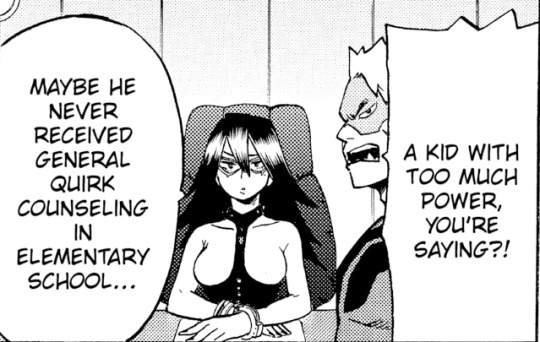
MIDNIGHT ‘Shōgaku-ji no “issei ‘kosei’ COUNSELING” uke tenai no kajira...’ ミッドナイト「小学時の『一斉〝個性〟カウンセリング 』受けてないのかじら...」 Midnight “Didn’t he receive “universal/mass/simultaneous ‘Quirk’ counseling” in elementary school?” [Chap. 22- Ep. 14]
From what Midnight says we can infer that ‘Issei “kosei” COUNSELING’ [一斉〝個性〟カウンセリング “universal/simultaneous/mass ‘Quirk’ counseling”] is given in elementary school as kind of a group activity or class lesson as ‘issei’ (一斉) generally is used to say “simultaneous”, “all at once”, which should imply all the kids at elementary school (or more likely, all the kids in a class) get it at the same time.
For contest, Midnight brings this up because they think Tomura has too much power and was never taught to ‘control’ it (as in not to use it to do what he wants). So we can guess Quirk counseling would, in their mind, have given Tomura a better grasp of what was allowed to do with his Quirk and what wasn’t (with becoming a Villain being definitely on the ‘Don’t do it’ list).
The discussion about Quirk counseling won’t progress any further.
The next time Quirk counseling is mentioned is in chap. 165.
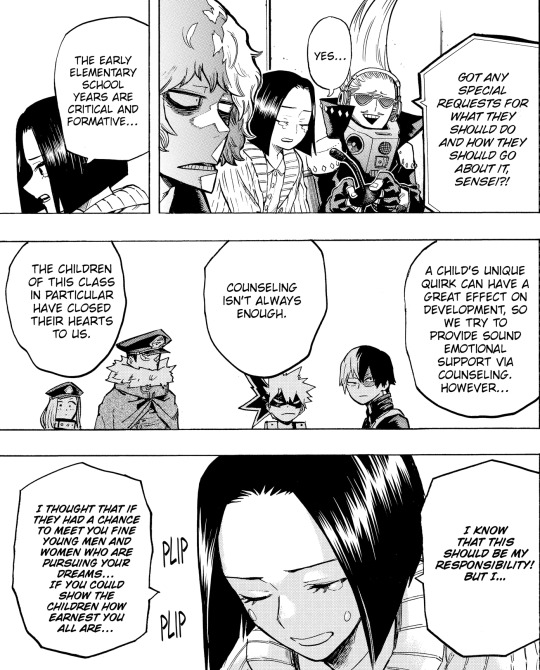
Ikoma Komari ‘Hai… shōgakkō teigakunen wa jinkaku keisei ni oite taisetsuna jiki desu...〝Kosei〟 no chigai ga ōkiku eikyō suru tame COUNSELING o okonai. Sukoyakana seishin o hagukumeru yō SUPPORT suru no desu ga... COUNSELING mo bannōde wa arimasen. Kono CLASS no ko-tachi wa watashi-tachi ni kokoro o tozashite shimaimashita. Watashi no sekinindearu koto wa shōchi shite imasu...! Desuga...! Yume ni mukatte hagende rassharu minasama to fureau koto de massuguna kimochi o omoidasa sete age rarereba…’ 生駒小麿里「はい…小学校低学年は人格形成に於いて大切な時期です...〝個性〟の違いが大きく影響する為カウンセリングを行い。健やかな精神を育めるようサポートするのですが...カウンセリングも万能ではありません。このクラスの子たちは私達に心を閉ざしてしまいました。私の責任であることは承知しています...!ですが...!夢に向かって励んでらっしゃる皆さまと触れ合うことでまっすぐな気持ちを思い出させてあげられれば…」 Ikoma Komari “Yes... the early years of elementary school are an important time for personality development... differences in “Quirk” have a big impact, so we provide counseling. We support them in developing a healthy mind... but counseling is not a panacea. The children in this class have closed their hearts off to us. I know that it is my fault...! But...! I hope that by interacting with all of you who are working hard towards your dreams, we can help them remember their honest feelings...” [Chap. 165-Ep. 79]
Here we don’t talk specifically of Quirk counseling, just of counseling and of how ‘differences in Quirk’ have a big impact on personality development, also adding that counseling is not a fix-it-all. Ironically though, all the kids in the class seems to be the same according to their teachers, ‘mondaiji’ (問題児 “problem children”) who’re always ‘hanko-teki’ (反抗的 “rebellious”/“defiant”) no matter what she does despite them all having very different Quirks, children who have ‘closed their heart’ to them (aka they aren’t listening to them anymore) and feel they’re better than anyone else and it’s clear with this class counseling didn’t work at all.
We jump at chap. 226.
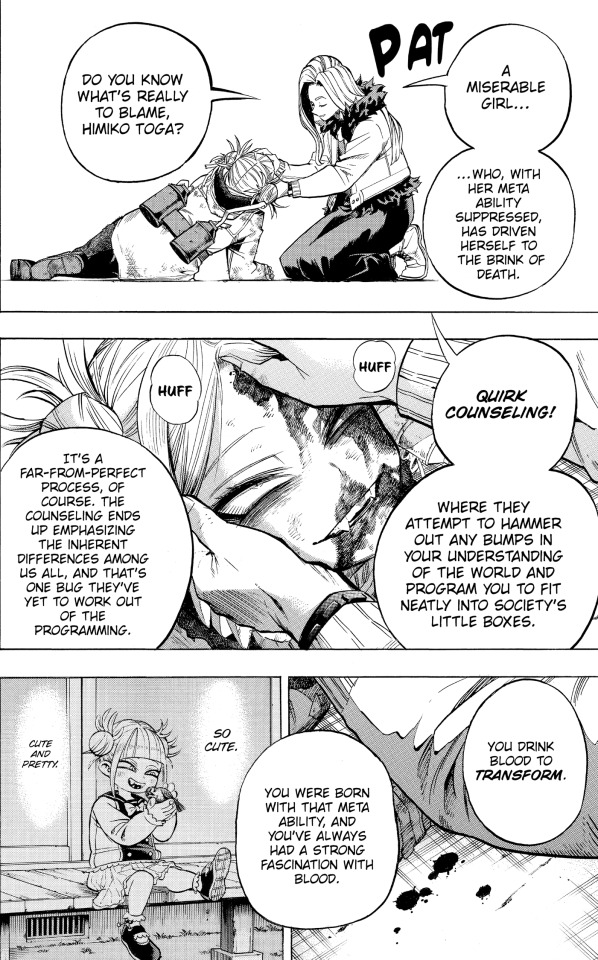
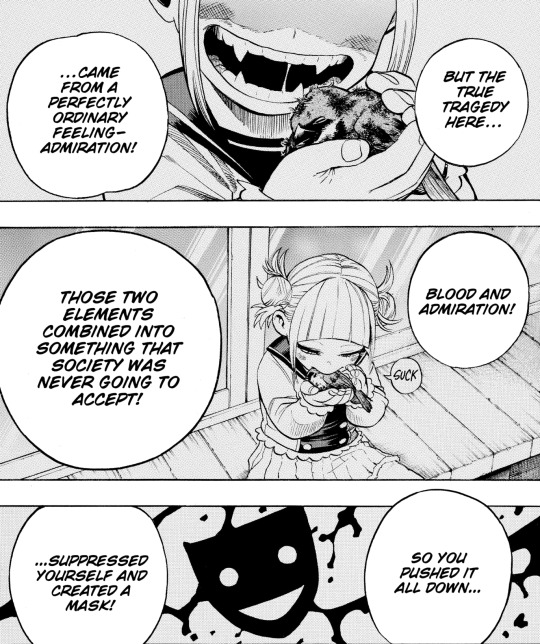
CURIOUS ‘Inō no yokuatsu ni yotte jibun o koroshita fukōna shōjo, sore ga anata nandesho? Toga Himiko. ‘“Kosei” COUNSELING’, jita rikai no yugami o kyōseishi shakaisei no suri awase o hodokosu jōsō kyōiku (read: PROGRAM). Mochiron, kanpekina PROGRAM de wa naishi, kojinsa o yori tsuyoku kanjite shimau to iu mondai o kakaete imasu. Chi o nomi henshin suru, umaretsuki motsu sono inō ni yotte anata wa “chi” ni tsuyoi kyōmi o hikareru yō ni natta. Shikashi shin no fukō wa “akogare” to iu dareshimo ga daku futsū no kanjō. Chi to akogare kamiatte shimatta nitsu no yōso wa tōtei shakai ni ukeire rareru MONO de wa nakatta. Dakara, anata wa FUTA o shita. Jishin o yokuatsu shi kamen o tsukutta.’ キュリオス「異能の抑圧によって自分を殺した不幸な少女、それがあなたなんでしょ?渡我被身子(トガヒミコ)。『〝個性〟カウンセリング』、自他理解の歪みを矯正し社会性の擦り合わせを施す情操教育(プログラム)。もちろん、完璧なプログラムでは無いし、個人差をより強く感じてしまうという問題を抱えています。血を飲み変身する、生まれつき持つその異能によってあなたは〝血〟に強い興味を引かれるようになった。しかし真の不幸は〝憧れ〟という誰しもが抱く普通の感情。血と憧れ噛み合ってしまった2つの要素は到底社会に受け入れられるモノではなかった。だから、あなたはフタをした。自信を抑圧し仮面を作った。」 Curious “You’re an unfortunate girl who killed herself by suppressing her supernatural powers, aren’t you? Toga Himiko. ‘“Quirk” counseling’, it’s an emotional education (read: program) to correct distortions in self-understanding and other things, and to adjust for socialization. Of course, it’s not a perfect program, and it has the problem of making individual differences even more apparent. Your innate ability to transform by drinking blood has made you very interested in “blood”. However, your true misfortune is “admiration”, a normal emotion that anyone can have. The two elements that go together, blood and admiration, were never going to be accepted by society. So you put a lid on it. You suppressed your confidence and made a mask.” [Chap. 226]
Episode 109 should be the one in charge to transpose this scene in animation but episode 109 cut the references to Quirk counseling.
CURIOUS ‘Inō no yokuatsu ni yotte jibun o koroshita fukōna shōjo. Sore ga anata nandesho? Toga Himiko. Umaretsuki motsu sono inō ni yotte anata wa chi ni tsuyoi kyōmi o hikareru yō ni natta. Shikashi, shin no fukō wa akogare to iu dareshimo ga daku futsū no kanjō to chi e no kyōmi, kono futatsu ga kamiatte shimatta koto. Sore wa tōtei shakai ni ukeire rareru MONO de wa nakatta. Dakara, anata wa FUTA o shita. Jishin o yokuatsu shi kamen o tsukutta.’キュリオス「異能の抑圧によって自分を殺した不幸な少女。それがあなたなんでしょ?渡我被身子。生まれつき持つその異能によってあなたは血に強い興味を引かれるようになった。しかし、真の不幸は憧れという誰しもが抱く普通の感情と血への興味、この二つが噛み合ってしまったこと。それは到底社会に受け入れられるモノではなかった。だから、あなたはフタをした。自信を抑圧し仮面を作った。」 Curious “You're the unfortunate girl who killed yourself by suppressing your supernatural powers. That's you, isn't it? Toga Himiko. The supernatural power you were born with has made you very interested in blood. However, your true misfortune was that your fascination with blood and your normal emotion of longing were intertwined. This is something that could never be accepted by society. So you put a lid on it. You suppressed your confidence and made a mask.” [Ep 109]
It’s a bad decision as Quirk counseling was meant to become important later but that’s what they decided to do.
Anyway in the manga there’s something we can work with, if before we were told Quirk counseling helps in developing personality, here it’s clarified the help is aimed at helping people to act ‘normal’, so that they can have a correct perception of themselves as well as socialize and interact correctly, the problem is it suppresses whatever is judged ‘not normal’ in a person and Quirks often generate wild differences between what’s normal for a person and what’s normal for another.
The result of this is that Quirk counseling ends up remarking in an even stronger way the differences between people, by forcing them to suppress feelings that are dictated by their Quirk.
We then jump to chap. 370.
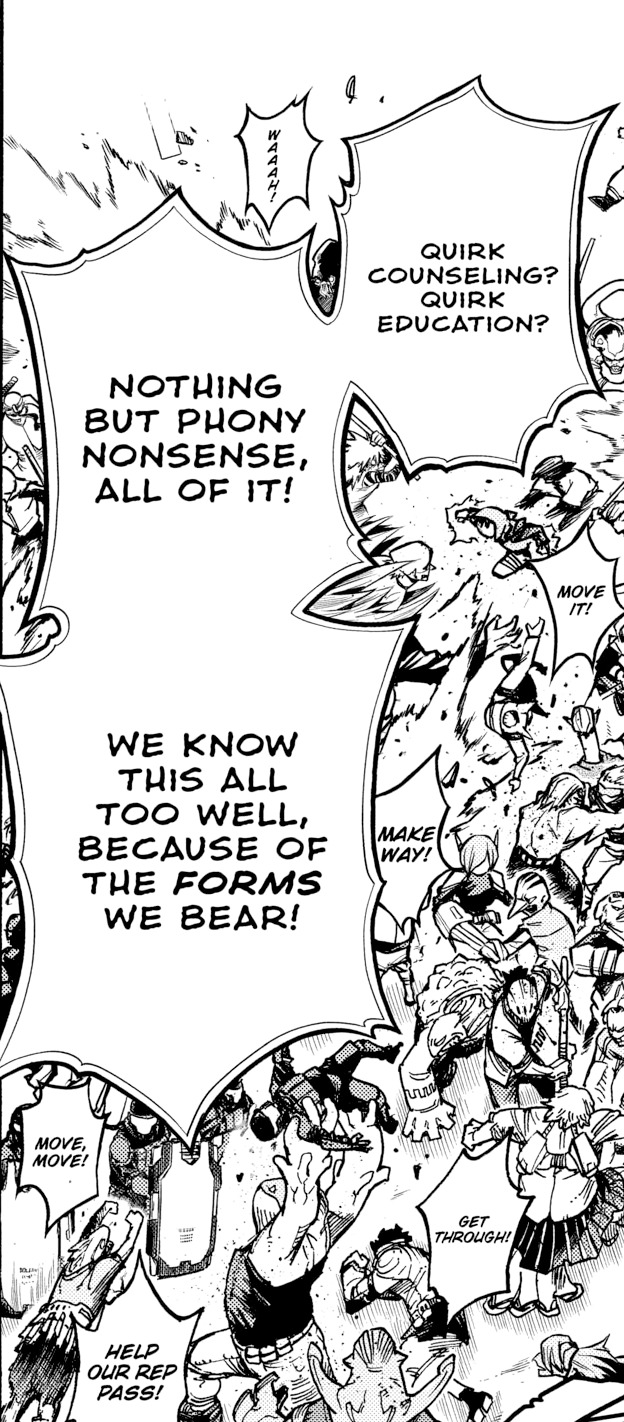
? ‘“Kosei” COUNSELING!” Kosei” kyōiku! Kore ga nise (read: mayakashi) de aru koto o! Wareware wa “katachi” o motte shitte iru!.’ ?「〝個性〟カウンセリング!〝個性〟教育!これが贋(まやかし)である事を!我々は〝形〟を持って知っている!」 ? ““Quirk” counseling! “Quirk” education! This is phony/bogus/sham (read: fake/deception)! We know it due to having this “shape/form”!” [Chap. 370-Ep. 152]
At this point we’ve a nameless heteromorph guy claiming Quirk counseling (along with Quirk education) is basically a sham, it’s not it didn’t work with that class of kids by coincidence, it’s just something that doesn’t really work with Heteromorphs.
While there’s not really an explanation we can guess that, if the point of Quirk counseling is making people ‘normal’, Heteromorphs, who in Japanese are called ‘Igyō’ (異形 “abnormal”), have a hard time with it, since they’re not normal by definition and can’t really change/suppress their ‘not normal’/‘heteromorphic’ traits.
We aren’t told what Heteromorphs are told during Quirk counseling, and the thing is made more complex by how somehow in big cities there’s no discrimination, while in rural villages people still go for ‘chiharai’ (血祓い “blood cleansing”), beating and scarring Heteromorphs who dare to come into contact with not-Heteromorphs, no matter if it’s to save them.
We then jump to chap. 392.
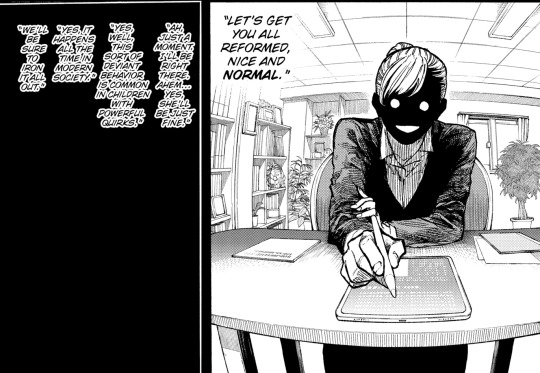
? ‘HAI kyōsei shite ikimashou “futsū” ni. A HAI mō chotto matte kudasai. Sugu sotchi ikimasu. Etto… ē daijōbudesu. Sō desu ne… tsuyoi “kosei” o motsu ko niarigachi na tōsaku desu yo. Kono shakai de wa yoku aru koto desu. Tadashite keshite ikimashou.’ ?「ハイ矯正していきましょう〝普通〟に。あハイもうちょっと待ってください。すぐそっち行きます。えっと…ええ大丈夫です。そうですね…強い〝個性〟を持つ子にありがちな倒錯ですよ。この社会ではよくあることです。正して消していきましょう。」 ? “Yes, let’s correct it and make it “normal”. Ah, yes, please wait a moment. I’ll be there right away. Um... yes, it’s okay. Well... it’s a common perversion among children with strong “Quirks”. It’s common in this society. Let’s correct it and eliminate it.” [Chap. 392]
Here we see a person talking with Himiko’s parents. We aren’t told this person is a Quirk counselor but, I guess, that’s the idea. It’s hard to say if she’s Himiko’s teacher or an external figure, however it makes clear Quirk counseling is more or less what Curious said. That person thought Himiko being fascinated by blood was wrong, she actually calls it a ‘tōsaku’ (倒錯 “perversion”), albeit one she labels as common, and tried to force Himiko to suppress her feelings so she could perceive herself and socialize with the others in a ‘correct’ way.
An interesting difference between the manga and the anime is that in the anime that person’s talk is more streamlined... and we see her also talking with Himiko's parents.


? ‘Hai kyōsei shite ikimashou futsū ni. Sō desu ne… tsuyoi kosei o motsu ko niari-gachina tōsakudesu yo. Kono shakaide wa yoku aru kotodesu. Sei shite keshite ikimashou.’ ?「ハイ矯正していきましょう普通に。そうですね…強い個性を持つ子にありがちな倒錯ですよ。この社会ではよくあることです。正して消していきましょう。」 ? “Yes, let's correct it and make it normal. It's a perversion that is common among children with strong Quirks. It's a common occurrence in this society. Let's correct it and eliminate it.” [Ep. 158]
This might imply that in the manga that person is actually busy with more things at once, she doesn’t have a lot of time to dedicate to Himiko’s parents and therefore she doesn’t have a lot of time to dedicate to Himiko.
Back to the conversation though, regardless of the source, the person talking makes clear that what Himiko does isn’t just something that’s “rude”/“inappropriate” to do in society but that it’s a “perversion”, a common one, yes, but a “perversion” and she says so to her parents who were already worried she wasn’t human.

Chichioya ‘Mō nekko ga!’ 父親「もう根っこが!」 Father “Her core/roots is/are already– (gone/rotten)!”
Hahaoya ‘Ningen ja nai ko un jatta!’ 母親「人間じゃない子産んじゃった!」 Mother “I gave birth to a child that isn’t human!” [Chap. 392-Ep. 158]
And later
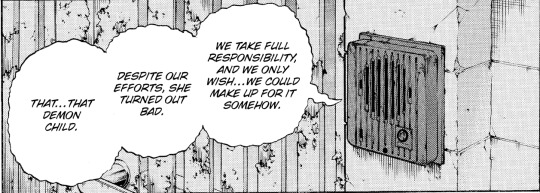
Hahaoya ‘Watashi-tachi ga waruin desu. Mō… tsugunai kirenai desu… ganbatta kedo damedattan desu… ano ko ha… akuma no konan desu.’ 母親「私たちが悪いんです。もう…償い切れないです…頑張ったけど駄目だったんです…あの子は…悪魔の子なんです。」 Mother “It's our fault. We can never make up for it. We tried our best but it was no use. That child is a demon's child.” [Chap. 226]
So Quirk counseling didn’t really reassure her parents nor solved Himiko’s problems. They weren’t going to accept that Himiko could have different feelings from the norm and help her to cope with them correctly, they just wanted to eradicate them from her. As she couldn’t, she was forced to suppress them… and since she couldn’t keep them bottled up forever they eventually exploded and lead her to hurt Saito.
The last time Quirk counseling comes up is at the end of the manga.

? ‘Tsudzuite wa TEAM-UP NEWS. INGENIUM, FROPPY, CREATI soshite URAVITY ga zenkoku no shōgakkō o megutte imasu. Teki (read: VILLAIN) hasseiritsu no genshō ni tomonai katsudō no haba wo hirogeru “HERO”-tachi sono naka demo-- URAVITY no uchidashita “kosei” COUNSELING kakuchō keikaku wa ima mottomo hitsuyō fukaketsuna katsudō to iwa rete imasu.’ ?「続いてはチームアップニュース。インゲニウムフロッピー・クリエティそしてウラビティが全国の小学校を巡っています。敵(ヴィラン)発生率の減少に伴い活動の幅を広げる〝ヒーロー〟たちその中でもーーウラビティの打ち出した〝個性〟カウンセリング拡張計画は今最も必要不可欠な活動と言われています。」 ? “Next up is team-up news. Ingenium, Froppy, Creativity and Uravity are touring elementary schools across the country. As enemy (read: Villain) occurrence rates decrease, the “heroes” are expanding the scope of their activities. Among them, Uravity’s “Quirk” counseling expansion plan is said to be the most essential activity right now.” [Chap. 430]
In this bit it seems that expanding Quirk counseling became a key factor in lowering the occurrence rate of Villains… which, of course, doesn’t seem to be possible since in almost all the other cases in which Quirk counseling was mentioned it turned out it either didn’t work (with the Masegaki elementary school kids) or made matters worse (Himiko and the heteromorphs). Is it a typing mistake as apparently the program already reached all the elementary schools so it didn’t need to be expanded and, anyway, didn’t work? Or does ‘expanding’ refers to actually put more resources and people in Quirk counseling so they can actually devote more time to the kids and help them better? Hard to say.
LOOKING AT THE CULTURAL CONTEST AND WHAT IT TELLS US
Counseling in Japan
While, of course, there’s no Quirk counseling in Japan, by 2006 Japan had school counselors (スクールカウンセラー) available in all the public middle schools. Prior to it though, this work was entrusted to the homeroom teacher (担任教師 ‘Tannin kyōshi’) and often also the school nurse (看護教諭 ‘Kango kyōyu’ ) who were meant to dispense discipline, encourage better conduct, increase motivation, provide career guidance, and offer advice. Those teachers though, were not trained in counseling, and it was often a duty they disliked, often choosing to use their classroom hours for something different than “moral education” depending on their personal educational agenda. Now instead, when problems arise, the teacher or the students or the students’ parents can ask help to the school counselor, which would also offer the plus of being a third party figure, so that they would be people not involved in evaluating students (and therefore have no conflict of interests with them) and would be professional in the field of psychology so as to offer better help to them.
Currently in Japan a school counselor visits a school about once a week to give children advice about various problems they face. School counseling is provided by clinical psychologists, psychiatrists and other professionals with expertise in mental health issues. In addition to advising children, the counselors can advise parents and teachers about how to handle their own day-to-day. A school counselor stands by in a counseling room where he or she listens to children’s problems one-on-one. Children can seek advice about whatever may worry them, such as relations with their friends, their family problems and uncertainties about their future and the counselor will advice them about how they should handle their problems while also talking with their homeroom teachers about what would be the best solution to each problem.
The problems with this system are often that the Clinical Psychologist isn’t also trained as a school counselor which leads with problems of interaction with the teachers, that there is confusion about the role of teachers and school counselors, and that there’s a HUGE stigma of shame at the idea of students or parents seeing a counselor. Much of the counseling that is now conducted in the Japanese schools is remedial with the individual as the focus; an approach that is contrary to the Asian interdependent view of self, an approach that seems to further exacerbate the student’s reluctance to see the school counselor.
It’s possible that Horikoshi, for earlier Quirk counseling, went with mix of the above, with it given both by the class homeroom teacher and by a specialist, or it given by the homeroom teacher only. It's not really clear.
Honne, Tatemae and Giri
Honne (本音 “true sound”) refers to a person's true feelings and desires.
Tatemae (建前 “built in front”, “façade”) refers contrastingly to the behavior and opinions one displays in public.
Giri (義理 “duty”, “obligation”) refers to the social obligations each person have.
Okay, fine, why should we care about these three words? Because Japanese people go to great length to hide their honne (true feelings) and show their tatemae (facade) so as to fulfill their giri (social obligation). They must do everything they can to avoid the disapproval of others, to avoid direct confrontation or disagreement. They’re completely justified in telling white lies to hide their true nature and present their Tatemae, so completely justified they can lie even in trial, that they’re expected to do so (remember when, in chap. 306, a guy said Enji should have just lied in regard to what Touya declared?).
Part of the Quirk counseling plan is clearly based on this, on teaching children how to show a socially acceptable tatemae and hide their own honne. This is what Himiko was taught, that her own fascination for blood was an unacceptable honne and needed to be buried inside herself if she wanted to be ‘normal’. That it was her duty to present herself as ‘normal’ and therefore show solely an acceptable tatemae.
Tōsaku (倒錯 “perversion”) and double meanings
As said before ‘Tōsaku’ means “perversion” and it’s used to describe how Himiko is fascinated by blood… but this is a word also used to describe sexual deviances… and Horikoshi clearly had fun with using words with double meanings in Himiko’s case, for example the onomatopoeia for sucking blood (ちうちう ‘chiuchiu’), sounds also like the onomatopoeia for kissing, Himiko is referred as a ‘ijōsha’ (異常者) which can be translated as “deviant” but also as “pervert” and so on. In short Horikoshi subtly create parallels between Himiko’s love for blood and the fact that Himiko’s way of loving people is not what in Japan is labeled as normal (she also loves girls and not just boys and would like to hurt people she loves). So, while Himiko’s problem of being fascinated with blood might seem distant from the audience as people in real world don’t have a Quirk that makes them fascinated with blood, the parallelism with sexual inclinations bring Himiko back into someone with whom people can relate and, in a way, someone that stands in parallel with Magne.
Heteromorphs, how ‘not normal’ they are meant to be and blood impurity
In English the word ‘Igyō’ (異形) had been translated as “heteromorph” but a better translation is “abnormal” or, more literally “not normal shape”. In a Quirk counseling program that aims at making everyone ‘normal’, who already starts with a name that states they’re not with a normal shape is clearly cut out of the race.
When Shouji talks of what was done to him he mentions ‘chiharai’ (血祓い “blood cleansing”) [Chap. 371] and, in the previous chapter, he was told he had ‘imi chi’ (忌み血 “cursed blood”) [Chap. 370].
Japan is very invested in blood purity, in pre-Meiji era Shinto and Buddhist traditions considered blood (血 ‘chi’) a source of symbolic pollution or ‘kegare’ (穢れ “uncleanness”, “defilement”) with elaborate rituals of avoidance and purification, however, in the Edo period (1603–1868) blood gained the positive meaning of “lineage”/”life force”, overtaking the preceding key metaphors for heredity. This though ended up causing the solidification of a hereditary status system that placed certain groups of people as being permanently “polluted” because they had works tied with blood, like executioners, undertakers, slaughterhouse workers, butchers, and tanners called ‘eta’ (穢多 “great filth”) as well as beggars, street performers, prostitutes, convicted criminals, and the physically disabled among others called ‘hinin’ (非人 “not people”) which together form the group called ‘burakumin’ (部落民 “village people”) and were considered outcasts. Their own blood was considered permanently impure, they were subject to increasingly stricter sanctions that prohibited their contact and mixing with the rest of society by means of restricted residences, economic activities, special clothing, hairstyles, and tattoos and since now blood also was a term used to define lineage, its polluting property also came to be regarded as inheritable and permanent which is why people still don’t want to marry (aka ‘mix blood’) with people whose ancestors were ‘burakumin’.
This was also made worse from the 1900 eugenicist obsession with blood as a medium to modernize the Japanese race and nation.The pure Japanese blood, or “Yamato blood,” was now heralded as a refined superior substance to be protected or enhanced through social programs of reproduction and health also through eugenic marriage counseling services.
This ultimately expanded to include people who had mental illness or familiar with mental illness but also with people who are of not pure Japanese ancestry. We would probably talk about genetics. In Japan it’s referred as blood.
Blood type is, in Japanese mentality, also tied with personality and discrimination can be so high that some would just discriminate people with blood type B or AB as negative stereotyping credits the B types as selfish, and ABs as eccentric and unpredictable and therefore more prone to have a loose morality.
As a result even if Shouji being a Heteromorph is tied to his Quirk and his genes, the story talks about his ‘cursed blood’… and people could refer to it also in relation to how the Todoroki are related to a criminal, Touya/Dabi.
(Plus this also tells you why Himiko's fascination for blood could NEVER be accepted since things related to blood lead to impurity)
While all this doesn’t tell us much about Quirk counseling, it helps to get a better perspective on why blood is mentioned when Heteromorphs are discriminated and how strong discrimination can be based to blood ties, clearly making it something that can’t be overcome with just the discriminated person in question trying to ‘act normal’ by presenting an acceptable ‘tatemae’.
The series leaves unclear what exactly falls into the Heteromorph category because, if the problem is just the shape being not normal, things like having tapes in your arms or engines in your legs, or horns on your head also give you an abnormal shape. Overall we can assume that the more the shape is abnormal and hard to ‘disguise’ as normal, the more one ends up being considered as an Heteromorph (Shouji’s arms are a much more visible ‘abnormal’ trait than Iida’s legs or Sero’s arms).
Just so you know currently Japan lacks any law which prohibits racial, ethnic, or religious discrimination nor has any national human rights institutions. Although racism exists it’s a taboo topic. In the past in the name of national unity, the Japanese government identified and forcefully assimilated marginalized populations, which included indigenous Ryukyuans, Ainu, and other underrepresented groups, imposing assimilation programs in language, culture and religion. Japan considers these ethnic groups as a mere “subgroup” of the Japanese people and therefore synonymous to the Yamato people, and does not recognize them as a minority group with a distinct culture. This is why in the story Heteromorph discrimination isn’t punished but it could also be the basis for why the Quirk counseling doesn’t keep into consideration how Heteromorphs are different but tries to force them too to act ‘normal’.
Quirk
We’re all familiar with the term Quirk that in Japanese is ‘kosei’ (〝個性〟 always written between quotation marks) which, translated literally means “individuality” or “personality”. In a country that is group oriented, values uniformity and thinks standing out is bad, Quirks that instead grant an even more marked ‘individuality’ and that are unique to each person, should feel like a big deal… but also it you tie a superpower with your personality you might get some unpleasant combo that aren’t really meant to be. For example thinks at Tomura and at how his Quirk destroy/decay things. If you think that his Quirk is his ‘personality’ or tied to it, you get the idea Tomura is someone who can only destroy/decay, that has a destructive character, or that who has an animal Quirk has an animal character.
WHERE ALL THIS LEAVES US?
Japanese youths have been fighting so as to have their individuality recognized in various subtle ways but it’s still an ongoing battle. The same goes for the descendant of the Burakumin and for people in the LGBTQ+ community. Sadly most of those topics are kind of considered taboo to discuss in Japanese culture so it’s possible that Horikoshi’s attempt at saying that Quirk counseling would be improved is a subtle message that’s meant to say that in the BNHA world steps would be taken to improve the acceptance of those people and the recognition of each person’s individuality, implying more a change into mentality/education than a change into some institutionalized thing called ‘Quirk counseling’, hence he didn’t need to develop much how it would work.
Of course mine is purely speculation.
Ultimately, if we solely look at the story, how Quirk counseling work/is administered is hardly well explained in the story, and how is reformed is explained even less (saying just it underwent an expansion) as well as why Uraraka, who had no idea of Himiko’s problems with Quirk counseling, decided to focus on it. But it’s likely the cultural context that’s meant to make it work for Japanese readers using solely what little is explained as reference and, for them, improving it, is likely a big step.
For whose of us who are instead cut out from the whole cultural context, there’s just too little to work with and it feels forgettable and confusing.
Okay, my analysis originally was meant to end here but then chapter 431 was released and it talked about Quirk counseling and so I added this extra bit.
CHAPTER 431 AND WHAT IT TELLS TO US
In the volume version only chapter 431 we have a last mention of Quirk counseling, which ‘shows us’ a bit how it’s done now.





Uraraka Ochako ‘Masaka senpai-tachi no tsugō ga tsuku to wa‼ Kitto minna yorokobimasu!’ 麗日お茶子「まさか先輩たちの都合がつくとは‼きっと皆喜びます!」 Uraraka Ochako “I never thought my seniors would be able to make it! I'm sure everyone will be happy!”
Tōgata Mirio ‘Ore nankade ī no kana‼’ 通形ミリオ「俺なんかでいいのかな‼」 Tōgata Mirio “I wonder if I am the right person for this?”
Hadō Nejire ‘Nande sonna koto iu no? Fushigi!’ 波動ねじれ「なんでそんな事言うの?ふしぎ!」 Hadō Nejire “Why would you say that? Strange!”
Amajiki Tamaki ‘URAVITY no “kosei” COUNSELING ni kyōryoku dekiru nante kōei da yo.’ 天喰環「ウラビティの"個性"カウンセリングに協力できるなんて光���だよ。」 Amajiki Tamaki “It's an honor to help Uravity’s ‘quirk’ counseling.”
Uraraka Ochako ‘Kono gakku no jidō no shiryō-me o tōshite moratta to omoundesu kedo nani yori daiji na no wa COMUNICATION desu. Ikken nan no mondai mo nai ko demo nayami o shimaikonderu koto ga ōi desu. Daishō towazu toku ni katei kankyō nanka shotaimen no otona ni hanaseru hito wa ōkunai desu. Demo jikan o kakereba kanarazu SAIN o dashiteru koto ni kidzukeru node shiryō ni tayori sugizu! Meyasu wa ikkagetsu teido desu ga naiyō shidai de zenzen hendō shimasu. Kazu wa ishiki shinaide otomodachi ni naru tsumori de!’ 麗日お茶子「この学区の児童の資料目を通してもらったと思うんですけど何より大事なのはコミュニケーションです。一見何の問題もない子でも悩みをしまい込んでる事が多いです。大小問わず特に家庭環境なんか初対面の大人に話せる人は多くないです。でも時間をかければ必ずサインを出してる事に気付けるので資料に頼りすぎず!目安は一か月程度ですが内容次第で全然変動します。数は意識しないでお友だちになるつもりで!」 Uraraka Ochako “I think you've looked through the materials about the children in this school district, but the most important thing is communication. Even children who appear to have no problems often keep their worries to themselves. Not many people, can talk to adults they meet for the first time, about problems big or small, especially about their home environment. But if you take your time, you'll definitely notice the signs, so don't rely too much on the materials! The guideline is about a month, but it can vary greatly depending on the content. Don't worry about numbers, just try to make friends!”
Amajiki Tamaki ‘Taihen da ne.’ 天喰環「大変だね。」 Amajiki Tamaki “That's tough.”
Uraraka Ochako ‘Zenzen! Jin'in no SUPPORT wa jūbun desu shi minasan sugoku teinei na oshigoto o sarerun desu yo. HAWKS ga monkashō ni kake attari kakusho ni kyōsan o tsumettari shite kurete “kosei” kyōiku no kankyō wa daibu kaizen sarete kiterundesu.’ 麗日お茶子「全然!人員のサポートは十分ですし皆さんすごく丁寧なお仕事をされるんですよ。ホークスが文科省に掛け合ったり各所���協賛を積めったりしてくれて"個性"教育の環境はだいぶ改善されてきてるんです。」 Uraraka Ochako “Not at all! There is enough staff of support and everyone does a very careful job. Hawks has been negotiating with the Ministry of Education and providing support from various places, and the environment for ‘Quirk’ education has improved considerably.”
Amajiki Tamaki ‘Jā ima wa jibun no tame no jikan mo torerunda?’ 天喰環「じゃあ今は自分の為の時間も取れるんだ?」 Amajiki Tamaki “So now you have time for yourself?”
Uraraka Ochako ‘Gimu toka… sekinin toka nai wake ja nai desu kedo ato kara tsuitekita mono desu. Yorokobu kao o miru no ga suki nandesu. Watashi ga yaritaikoto shitemasu. Tsuyu-chan mo hobo zutto TEAM-UP shite kureteru shi tomodachi to mo aeteru shi zenbu jibun no tame no jikan desu yo!’ 麗日お茶子「義務とか…責任とかないわけじゃないですけど後からついてきたものです。喜ぶ顔を見るのが好きなんです。私がやりたい事してます。梅雨ちゃんもほぼずっとチームアップしてくれてるし友だちとも会えてるし全部 自分の為の時間ですよ!」 Uraraka Ochako “It's not that I don't have obligations or responsibilities, but they came after. I like to see people's happy faces. I'm doing what I want to do. Tsuyu-chan has been teaming up with me almost all the time, I've been able to meet up with my friends, and so it's all time just for myself!” [Chap. 431] Now, I’m not 100% sure if the idea is to always involve Pro Heroes or ‘the supporting staff’ can be composed also of ‘not Pro Hero’ people, but we get a general idea of what the people who decide to take part to the project should do. They read the documents about the kids, they’re encouraged to make friends with them, possibly/likely involving them in a game in which they use their Quirk which will allow them to receive what we can call ‘Quirk positivity’. All this in order to help children to open up and talk about their (Quirk related) problems. This last for around a month then, if no problems are detected (or if they are but they’re solved by that time), the people involved move to another school.
Now… maybe it’s just me but this is basically what was done during the ‘remedial course’ arc with the kids from the Masegaki school, only, they’re given documentation about the kids and, instead than lasting one time, it last one month and it involves Pro Heroes, not Heroes in training who might not be interested in interacting with children but are forced to do it if they want their license.
In this sense the whole ‘expansion’ thing of chapter 430 finds it’s explanation. Heroes are expanding their activities (aka also taking part to other activities like Uraraka’s Quirk counseling program) and the Quirk counseling program is being expanded as well as now its scope isn’t anymore to just help children to fit into the standards of normalcy society created but to offer them Quirk positivity and to create a connection so that THE CHILDREN will be willing to talk about their problems with Quirk and with their family.
Storywise it’s a pity the original characters involved in the ‘remedial course’ arc aren’t mentioned as being involved in all this, especially Shouto (who not only had an extremely troublesome Quirk related family situation plus a brother with problems with his Quirk who almost killed himself, was targeted by a Villain, became a Villain and eventually died). Yes, we can picture they are, but, as far as canon is concerned, he isn’t mentioned AT ALL, not even as one of the sources of inspiration for how Uraraka’s project is structured (canon also didn’t show Bakugou or Shouto talking about their remedial course with classmates) but okay, this isn’t really related to Quirk counseling.
Now with all those additional info I can talk a bit of something else aka:
REALITY CHECK
Uraraka’s project is nice and well meaning but it’s also very fairytalesque, in the same way as Hawks claiming that Heroes having free time would be a good thing. It’s all well and good and, since BNHA is a tale, I’m sure it’ll work like a charm and if you want to stop reading here and enjoy such a happy world I’ll understand you.
However if you want to know if this will work in the real world…
In the real world, if the request for Heroes were to decrease because there are less Villains (and having less Villains would surely be a good thing), it wouldn’t mean people would hire the same amount of Heroes and keep on paying them just the same, we would simply have more unemployed Heroes or society would self regulate itself by simply giving out less and less Hero licenses. In short, society would NEVER allow Heroes to have more free time, it would just hire less Heroes or, in the very best case, pay them less. Sure, the problem can be solved with Heroes reinventing their job, for example volunteering to take part to Uraraka’s Quirk counseling project so as not to lose their job and their source of income.
With this though, comes a worsening of the main problem I see in Uraraka’s Quirk counseling project.
There is no mention whatsoever that the people involved are TRAINED to spot (Quirk related) psychological problems. Kids with psychological problems (due to their Quirk and family environment reacting badly to their Quirk) aren’t necessarily always showing a villainous behavior or a transgressive behavior (which is what Heroes are trained to spot), they can be acting as ordinary well behaving kids, or be meek or be people pleasers or vivacious but apparently harmless kids.
While it’s true that elementary school kids are generally more direct in their actions and reactions, some of them could have already mastered the fine art of hiding/masking things for fear of repercussions or due to them being educated to lie about certain things or even being made believe in such lies so they don’t even know they’re lying anymore.
Quirks, it’s worth to mention, don’t necessarily manifest at 4, they can manifest as early as their childbirth (see the luminescent baby or AFO himself), and sometimes a child can be born in a house where the ‘Quirk problems’ are caused by the parents’ expectations (think at how Enji wanted his children to have a certain Quirk and inherit his place). In short they might have been forced BY BIRTH to interact with ‘unpleasant’ situations and might have also been forced to learn to cover them up.
Fuyumi for example, lived in a toxic environment but, likely, masked that up well. Himiko took longer at learning to mask it up well, but her Quirk manifested when she was areound 3 or 4 and gave her a really strong instinct, for which she was left with zero family support (actually her parents’ reaction is completely out of proportion, kids at that age do plenty of stupid and gross things and then can grow up perfectly normal provided they’ve normal parents to guide them, there was totally no need to beat Himiko up and panic like that) and yet she learnt to mask it perfectly by the time she was in middle school, possibly even sooner as the journalists couldn’t find early signs and they likely searched for them like starved piranha.
In truth even professionals might miss the signs or might approach children in the wrong manner, causing more troubles than good because it’s a HARD job… so the idea that if completely untrained adult people who just read some data about the children (which might have been written by who already missed the signs or is misinformed about the real situation of the children) were to make friends with them, they would surely get them to open up or would surely notice signs that something is wrong and act in the appropriate manner to fix it is… well… very naïve.
It’s well meaning and it can surely help in some cases but, unless Japan had a REALLY ABNORMAL PROBLEM so that the TINIEST help would make a BIG difference, don’t expect the big change the press is talking about… especially if Heroes who have no more Villains to capture and zero interest in helping kids will be ‘forced’ to join the program so as not to become unemployed.
On the other side the lack of psychological preparation in people can be very well explained with how there’s a strong stigma in Japan regarding psychological problems.
The reason why real life normal counseling is often not used in Japan is because Japanese people don’t want to talk with a Clinical Psychologist (as said before now that’s the specialization a counselor needs to have) so Horikoshi’s ‘hey, but those people are normal, well meaning people, possibly even Heroes kids admire, not psychologists so talking to them doesn’t mean you’ve psychological problems so you can totally open up with them safely’ is meant to address this fear and, of course, it’s better to talk to an untrained person than not to talk at all so in this vein, this could be seen as an ‘improvement’.
I don’t know but I guess this is now really all we have about Quirk counseling.
Said all this, which is likely still an incomplete overview, I hope my ramblings will help people to understand Quirk counseling better. If not, I apologize.
#boku no hero academia#bnha meta#mha meta#bnha spoilers#Toga Himiko#bnha observations#bnha ramblings#Uraraka Ochako#Kayama Nemuri#Ikoma Komari#Kizuki Chitose#Iguchi Shuuichi#Shouji Mezou#Shigaraki Tomura
99 notes
·
View notes
Text
Age analysis:
- Meta Liberation Army -
(Please ignore all my spelling mistakes, I overthink too much)

Skeptic/Tomoyasu Chikazoku:
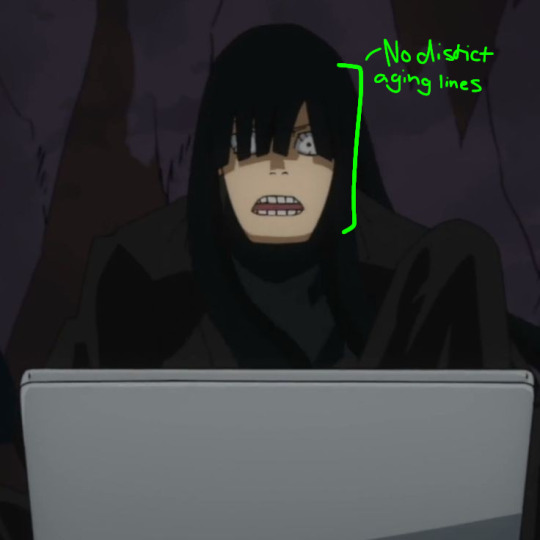


- I've noticed that he really doesn't have any major aging lines or details in his design, although his eye bags and chin details could be seen as his aging, it just seems that they are just part of his face shape and his working habits.
Ex: His eye bags would probably form from his time in front of computers and in dark rooms
My age guess for him would probably be his late 20's, maybe 27 or 28
----------------------
Trumpet/Koku Hanabata:
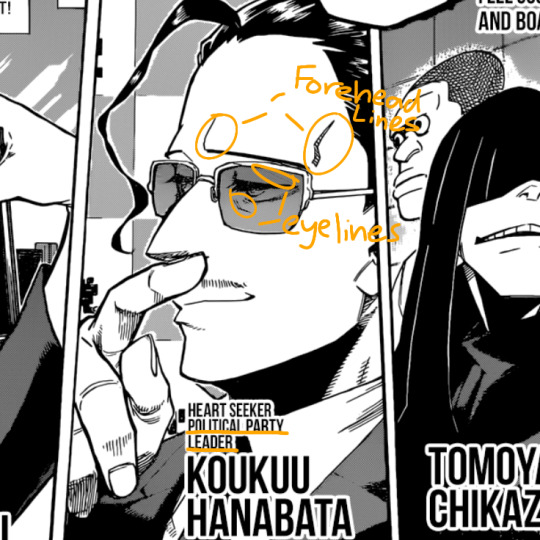
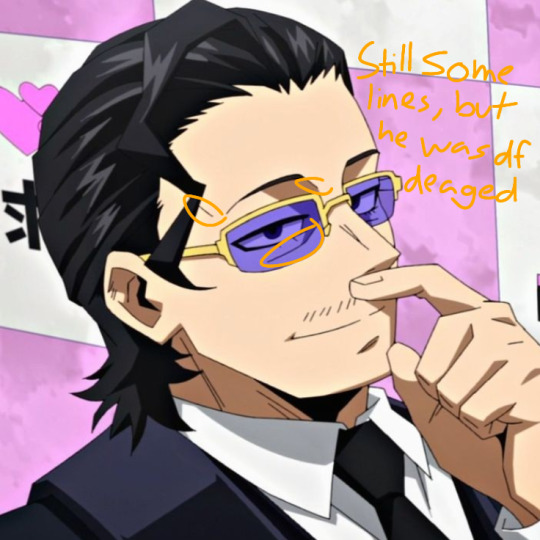
- Trumpet is very obvious not young, a lot of his dialogue is very formal and he does say "My, is that what the kids are saying these days?" + He's a political party leader, where you would have to be a certain age to legally be a party leader. He very obviously in either his late 30's or early 40's. He also has obvious aging lines in the manga. Eye lines and forehead lines are apparent, but I hate how they took them away in the anime, but all of the MLA got screwed over by Bones
Age Guess: About 42 or 43
----------------------
Curious/Chitose Kizuki:
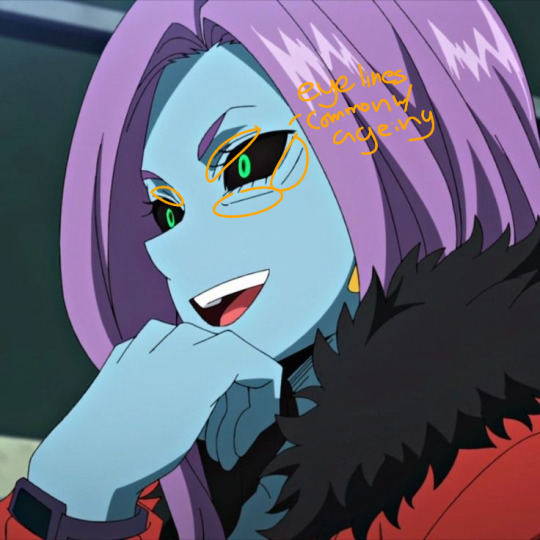
- It's obvious that she's aged, she has the same eye lines in the manga, so I couldn't find any more description or design for her age. But it's very clear that she is over the age of 30. Eye lines are very common aging factors and by her small flashback with Re-Destro, she was definitely around her 30's cause of Re-Destros design at the point
Age Guess: Around 41, possibly 42
----------------------
Re-Destro/Rikiya Yotsubashi:


- We all know our favorite silly old man. He has very very clear aging lines, along with stress lines as well (his ability side effect). Also considering he's a CEO of Dentrant, the grand commander of the MLA, and his speech pattern, he's finely aged.
Age guess: Around 45, possible 46.
----------------------
Geten:
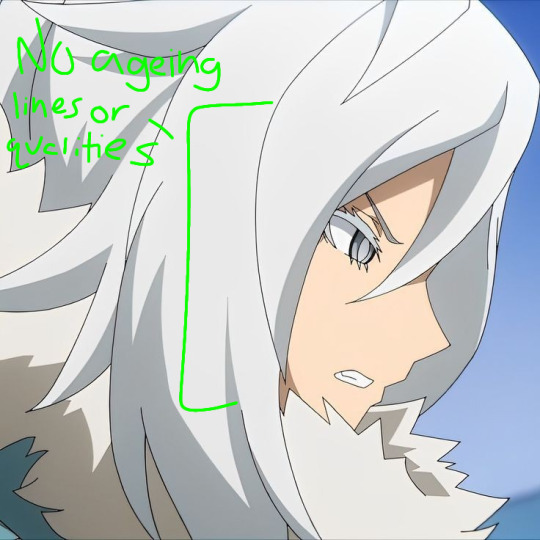
- Geten is very obviously not aged at all. He has a young character design, but it's said that he never went to school, and ran away from his family young, cause fuck his family (they are so gross and what they did to Rei ruined her life.)
Age guess: Around 20 or 21. I really don't think he's older than that, still very young by MLA standers
#mha#bnha#analysis#age#rikiya yotsubashi#koku hanabata#tomoyasu chikazoku#chitose kizuki#yotsubashi rikiya#hanabata koku#kizuki chitose#chikazoku tomoyasu#skeptic#trumpet#redestro#curious#geten#bnha geten
76 notes
·
View notes
Text
Hear me out, just hear me out! These two... 👀
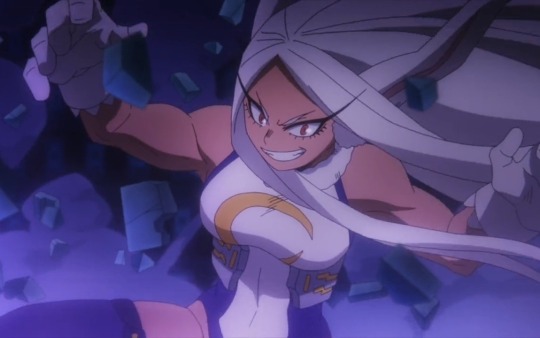
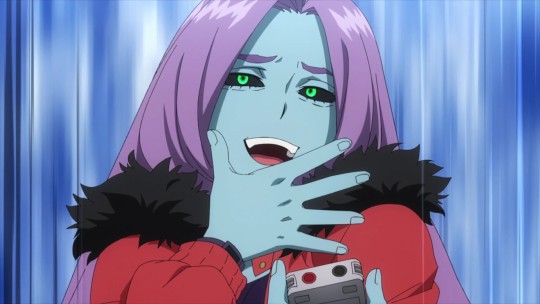
#look y'all already know i find rarepairs fun#curious and miruko? THAT#you cannot tell me curious would love to interview miruko and enjoy everything she tells her#and vice versa miruko has someone interview her that doesn't bore her#also enemies and lovers??? HELLO???#better yet unknown enemies and lovers???!!!#DO Y'ALL SEE THE VISION?!#just kiya's thoughts#bnha#mha#boku no hero academia#my hero academia#miruko#mirko#rumi usagiyama#usagiyama rumi#curious#bnha curious#mha curious#chitose kizuki#kizuki chitose#curiousbunny#chirumi#mirucuri#wlw ship#bombbunny
186 notes
·
View notes
Text
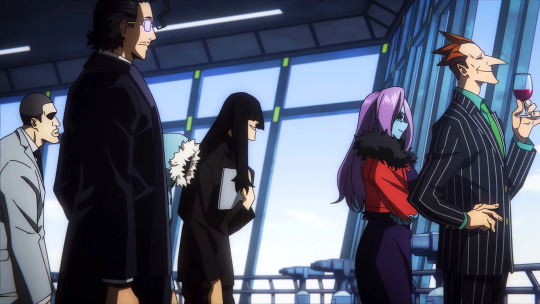
They are rotting my brain again. Psychopathic Cult Leading freaks. I love them so much and it makes me sad how badly Studio Bones fumbled them, leading to less content of them. It's not like they were ruined, but they could have been so much more, and were so much more, because the Manga is right there.
Anyhow that was all just preamble for the point of this post, Fic Recs! Any cool fics involving any combination of these characters, please! Any length, any genre, just. As long as any of these guys have the spotlight.
#villainous ramblings#mha#bnha#my hero academia#boku no hero academia#tomoyasu chikazoku#kizuki chitose#chitose kizuki#koku hanabata#yotsubashi rikiya#geten himura#mha skeptic#mha curious#mha trumpet#mha re destro#ah yes the five most influential aspects of society#Capitalism Journalism Politics Technology and ice ice baby#meta liberation army#paranormal liberation front
82 notes
·
View notes
Text

Hero in training distracted by cute villain. Dozens perish
No seriously. Other than Shouto not catching the Baku-marble before Dabi which eventually leads to Kamino, this is the mistake from this arc with the biggest body count because Toga uses the blood from this confrontation to kill Curious and her lackeys.
61 notes
·
View notes
Text
KIZUKI 'CURIOUS' CHITOSE ICONS!!💚💜


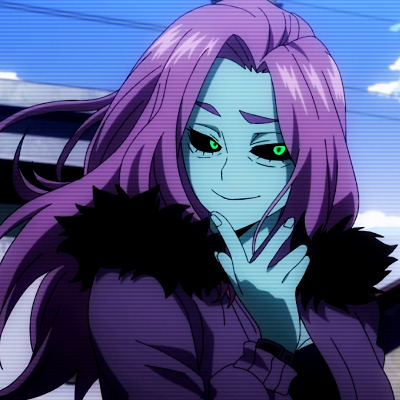

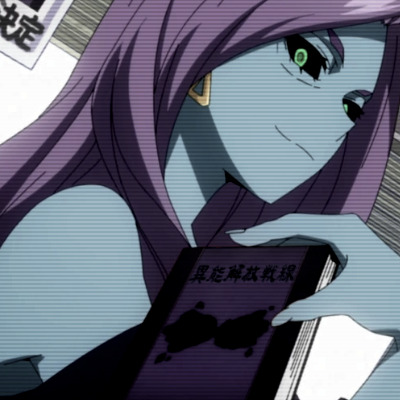



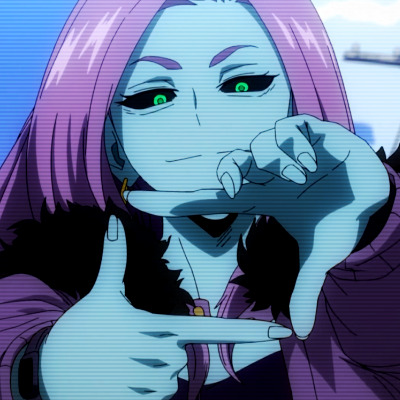

🖤BNHA IMPORTANT POST
📘BNHA SUGGESTIONS POST
🤔KIYA’S EDITS REQUESTS RULES!!
#kiyaedits#bnha#mha#boku no hero academia#my hero academia#bnhaedits#bnhaedit#anime icons#bnha icons#mha icons#kizuki chitose#chitose kizuki#curious#curious bnha#curious mha#meta liberation army
35 notes
·
View notes
Text
2 notes
·
View notes
Text
#AO3 Feed Link#FanFiction#AO3 Kirishima#♠#Eijirou Kirishima#Tomoyasu Chikazoku#Rikiya Yotsubashi#Kizuki Chitose#💎#R:T#A:Goofy Boss
1 note
·
View note
Text
Realized that the panel from Ochako vs Bakugo looks similar to toga vs kizuki. 😭


It's kinda a given that they'd be similar, considering they're using the same quirk and they're both dropping things. But still, I like the similarities.
#my hero academia#uraraka ochako#himiko toga#toga himiko#ochako uraraka#ochako vs bakugo#mha chapter 36#mha chapter 226#kizuki chitose
2 notes
·
View notes
Text
#AO3 Feed Link#FanFiction#AO3 Ponymina#♣#Ponymina#Kizuki Chitose#Cathleen Bate#👽#🐂#⚢#R:G#A:Wezko#Sex Swap
1 note
·
View note
Text


The hot ladies of my hero academia anime
#my hero academia#boku no hero academia#my hero academia vigilantes#makoto tsukauchi#tsukauchi makoto#chitose kizuki#kizuki chitose
0 notes
Text
Updated version of "Quirk counseling: canon, the cultural references and what we can guess from this all" which now has the bit about Chap 431
So you might have been familiar to my previous post about Quirk counseling. As the volume only chap 431 added more info about Quirk counseling I've updated my post to include them.
If you're interested in reading the new bits you can find them clicking here: Quirk counseling: canon, the cultural references and what we can guess from this all (now with the bit about Chap 431).
They're at the end of the post under the title “CHAPTER 431 AND WHAT IT TELLS TO US”.
#boku no hero academia#bnha meta#mha meta#bnha spoilers#Toga Himiko#bnha observations#bnha ramblings#Uraraka Ochako#Kayama Nemuri#Ikoma Komari#Kizuki Chitose#Iguchi Shuuichi#Shouji Mezou#Shigaraki Tomura
7 notes
·
View notes
Text

"Curious was a valuable asset.. She didn't need to throw herself at the front lines" Let's see if this will get anywhere, the hair took forever to figure out-
#mha#bnha#minor artist#artists on tumblr#fanart#curious#chitose kizuki#meta liberation army#art#curious mha#trans artist#shes so pretty#rip curious you would have loved the lov being taken down#paranormal liberation front#lov#league of villains#my hero academia#kizuki chitose
34 notes
·
View notes
Text
I am so sorry. I apologize. But when I saw this child my brain immediately thought of him as some mash-up of Burnin and Curious. LOOK!



Eyes - Curious
Element Hair - Burnin
#it's a joke don't jump me#okay but his quirk and his choice to be a business course student is like something#he has electric powers#electricity is like... really really fast fire#take burnin's fire and curious' landmine and BOOM!!#like what's up with folks having fire powers in this series?!#also the business course thing!#i imagine that curious took business courses too for journalism work among other things#'unsung heroes in the background'... SO A SIDEKICK KIND OF?!#just kiya's thoughts#bnha#mha#boku no hero academia#my hero academia#bnha team up missions#mha team up missions#bnha tum#mha tum#moe kamiji#kamiji moe#burnin#burnin mha#burnin bnha#curious#curious mha#curious bnha#kizuki chitose#chitose kizuki#sanda raito#raito sanda
25 notes
·
View notes
Text
MHA AU IDEA: Lieutenant Bakugou "Scorch" Katsuki, of the Meta Liberation Army.
Ok! I've seen many many many many Vilain Bakugou AU's, we all have. But, they're all in te League! And I love the League, but they aren't the only villains! So, here's my completely random idea of putting Karsuki into the MLA!
So, first thing's first: How the heck does Katsuki even learn of, much less join the MLA? Simple: kidnapping Adoption!
But, seriously, the MLA is almost a political cult, and we do know that Geten was found by Re-Destro when he was pretty young, so, taking in an abandoned child one of them happened to find isn't too outragous.
But, Katsuki is far from abandoned or neglected. So, of course, my idea for how this all starts is a simple tragedy- Bakugou Mitsuki and Bakugou Masaru are both sadly killed in a horrific villain attack along with many other victims when Katsuki is only 6 years old, and happens when he's attending school.
Of course, young Katsuki does NOT take this well, and goes into full denial. No, his mom is stronger than that, his dad would never leave him behind, look harder for them, those can't be theit bodies because his parents can't be dead, just look harder for them god damnit!
He absolutely refused to be taken in by anyone or taken to any place to take care of him until they can figure out what to do with him, and with the help of his quirk, is able to run away and searh for his parents himself.
This obviously doesn't go well, and in two or three days, he's hungry, smelly, thirsty, and all alone. Still, he refuses to give up looking, but... a roof to sleep under wouldn't hurt.
Enter one Kizuki Chitose: Simply wondering around the area for a breath of fresh air and a potential scoop. Of course, she's absolutely not one to ignore a sad, abandoned looking child.
After talking to him, she quickly decides to bring him to her residence to clean him up and give him a good meal, which isn't terribly hard to convice Katsuki to allow. Now, she was going to report this missing child to the police, but, she couldn't help but want to know exactly what happened to this poor child.
And, after hearing his story, seeing how passionate about his quirk he was, his determination and grit at such a young age, she couldn't not become attached. And from there, it was a slippery slope.
At first, it was taking care of him for just a little bit longer, he deserved it, right? Then, it was being a little too open around the child and, well, it couldn't hurt to tell him a little about the Grand Commander's ideals, right? One thing turns into another, and suddenly, she's deciding to introduce the other Member's of the board to the newest "Liberation Warrior" and Geten his new baby brother. (What, he looked like he was getting lonely.)
Now, some people are less happy than others, (Skeptic had to hold himself back from verbally murdering her in front of a child) but in the end, Rikiya is happy to allow it.
At this point, an emotionally distraught Bakugou has come to the conclusion that yes, his parents are likely dead. He still doesn't wanna go to any big scary facility, but, shouldn't police at least know where he is? Chitose says they do, and have come to an agreement to let her take care of him, but only until they figure out what to do with him. Ah, she was always a great liar.
After a while, Chitose successfully indoctrinates Katsuki into just accepting this new life without any real question, so, success!
Now comes the part where he is stuffed absolutely full of propaganda the insightful and powerful message of Destro and Meta-Human Liberation.
Being so young, and so proud of his powerful quirk, he is very succeptible to it. So, over the years, Katsuki's pride and ego are encouraged, he's constantly praised for his quirk, and taught that might makes right. This leads to a Bakugou pretty similar to the start of canon, just, even worse, somehow.
Now, basically being the son of Chitose and brother to Geten, he kind of gets an in on the MLA (Skeptic also wanted to kill her for that), But! Only after many years, when he's reached an acceptable and trustworthy age! And by that she means on his 10th birthday.
So now, they have a young, extremely dedicated member of their organization, closely tied to multiple Lieutenits, and who is also very vocal about wanting to be a hero and go to U.A. (Although, he wouldn't need to go to U.A. to be a real hero in his ideal world, but, oh well), and who has an extremely powerful quirk with great potential. So, She has a great idea involving Katsuki, that for once isn't show down immediately by Skeptic.
"Why not send him to U.A. as a sort of, marketing piece? Having him be open about his beliefs in Liberation, as well as being the top of his class from the most famous and well respected schools in all of Japan, is sure to help us, yes?"
And thus, Kizuki Katsuki is enrolled in U.A., Blasting the good word of Liberation into the faces of those worthless extras he calls classmates! (Not too hard though, don't want to be seen as an extremist, just a passionate teenager).
I could go on with more ideas for how it changes the story, but, that's the gist of it, for now! Please, tell me what you think!
#villainous ramblings#mha#my hero academia#bnha#boku no hero academia#bakugou katsuki#katsuki bakugou#mha bakugou#bnha bakugo katsuki#mha au#mha au idea#bnha au#kizuki chitose#mha curious#bnha curious#re destro#rikiya yotsubashi#yotsubashi rikiya#mha re destro#mha skeptic#bnha skeptic#koku hanabata#mha trumpet#bnha trumpet#geten#geten himura#bnha geten#mha geten
48 notes
·
View notes
Text
Bones Studio Screwed Over The Meta Liberation Army So I’m Doing An Analysis To Complain:

(Slight Spoilers: Mentions of Season 7 and the Manga)
So, As the title suggests, I’m going to be complaining about Bones Studio and how they handle my favorite arc and my favorite characters and how basically they water them down where it’s kind of lame. As I have written this, This could change after written/posted. We’re on Season 7 and while they showed the very important battle of certain hackers. They missed an important part...
That is Geten and Mr. Compress talking in prison about Geten’s family being toxic. This was an important part to not only Dabi’s backstory to reveal the harmful ways the Himura family bred for improved and better quirks, but also important to Geten’s story as well since this revealed, Geten is related to Dabi. They removed that scene even though this involved Dabi is loved by fans. This is truly beyond me since I believe it was a crucial part of the story. In my personal opinion, I believe it’s a personal hatred of the Meta Liberation Army on Bones’s part…
Which is why… I’m making this post, talking about everything Bones Studio did wrong with the MLA Arc and the Meta Liberation Army, why this makes me angry, and the created differences between the Manga to Anime.
——————————
How Bones Studio Handled The Meta Liberation Army Arc:
This is an arc I absolutely love and is one of my favorites, Even in the anime it’s still my favorite. HOWEVER, I can’t forgive them for what they done to it. I personally believe that if the arc was animated properly and included the scenes missing, The MLA would have been almost as popular as the other villain groups and a lot more fans would be on board with them. Have you seen the merch for the MLA it is very little and usually exclusive to Japan. Now you must be thinking but “Myvillainacademiafan, They cut a lot of those scenes out to make it work for the anime!” I’m aware you gotta make room for time and other purposes. I’m aware some scenes don’t seem relevant. And yes, I’m aware some scenes might be inappropriate for a TV-14 rating. I “MAY” have forgiven them if it was only like a couple of times. BUT THERE WAS OVER A DOZEN SCENES CUT OUT, CHANGED, CENSORED, AND MORE. At that point, you might as well either create a new story with the amount of changes and bonuses made. Now let’s get to the changes…
——————————-
Re-Destro’s Introduction And The Proper Introduction Of The Army:
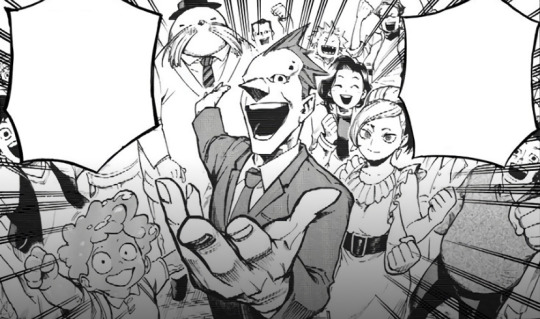
In the Manga, instead of the introduction of the Meta Liberation Army being the call with the League of Villains in the episode “My Villain Academia”. It’s actually when the UA students are hanging out and a certain commercial comes on the tv. It’s Re-Destro advertising for his company Detnerat. The commercial shows how the company is to help people in society with mutant like quirks or abilities live in the world easier with the help of their items. (I would also say that in a way, whether his company or the army, he wants citizens to live freely with their powers and this commercial was a perfect way to show that). After the commercial plays, it turns out it was being watched by Re-Destro and his assistant as well. (they don’t even reveal his assistant in the anime. Rip Miyashita for not getting an anime adaptation…)
The two talk for a bit when suddenly Re-Destro lets the word “Meta Ability” slip. Miyashita questions this and this was a perfect time to advertise Destro’s book “Meta Liberation War”. While he was hoping the assistant would be on board of the Meta Liberation Army, Miyashita however wasn’t convinced and saw this book as harmful and Destro nothing but a “Ranting Criminal” So with a slight uncomfortable and chilling scene, Re-Destro makes sure the man didn’t have any close loved ones before cracking his neck. After doing so, He expressed not only disappointment in Miyashita disliking the book and insulting Destro, but mourned the loss of the life taken…
After this we get the familiar scene we got with Re-Destro walking in to the lieutenants of the army to talk about their updates of the league in the episode “Revival Party”…
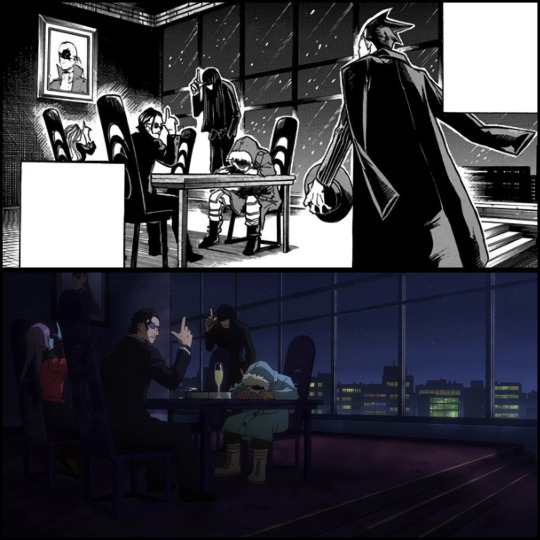
Why Removing This Scene Was Wrong And Makes No Sense:
While starting with the call for the League Of Villains is good at giving Re-Destro a mysterious feel to him, I believe you still would have gotten the same even if you included the original scene. Not only that, but it gives Re-Destro some unpredictably with how he’s going to react when you insult basically his lively hood. The commercial was a smooth and charming introduction of the character himself and having him talk and introduce the book was an excellent way to introduce the reader/viewer to the next arc. The murder of Miyashita was also an excellent way to introduce the threat and uneasiness of the Meta Liberation Army and what’s to come, Especially since it perfectly transitions to the fight with the ice villain fighting Shoto and Bakugo and that the villain was using Detnerat products. (Revealing panels later that Detnerat also helps villains in the black market as well)
In the anime, nobody is going to understand the ice villain and why his weapon was destroyed after he was caught because the manga explains better with the context. People were confused at first on Slidin Go’s sudden appearance and relevance to the story, (however, that could be a fault on both ends). When you go straight to the phone call for the introduction and appearance of the army. A lot of people were confused on who the hell those guys were anyways. So, instead of seeing them along the story and getting excited to see them finally go into action when the League of Villains do fight in Deika City. You’re left a bit confused with the anime…
AND SPEAKING OF CONFUSION, Is anyone going to talk about Giran in this?…
————————————
Giran’s Sudden Kidnapping In The Anime:

While both the anime and the Manga don’t reveal how Giran got captured in the first place. The Manga added a bit more understanding compared to the anime. Before they show Giran in the Manga, We cut to the Meta Liberation Army talking with each other about Re-Destro’s black market items. (Which was played exactly after the ice villain was arrested. Literally a perfect transition and explanation on to the MLA as a threat and why everything happened the way it did) To which Skeptic told Re-Destro their “Guest” has arrived. We see Giran being dragged in by two body guards. And while the army has tried to beat and threaten the information out of Giran. He refuses to sell out his clients/League… And then after that we cut to the introduction of Gigantomachia like how we have in the anime.
…For the Anime, He’s just already there… He’s already Kidnapped, tortured, and had his stuff recovered while looking sad… Where’s the stubborn refusal and where’s the context on the anime’s part? While I guess it could be forgiven, they went easier on Giran in the anime given that his bruises are a lot more tame compared to the manga. It’s just confusing to have him suddenly there with not really any context. BTW, in the manga, they LITERALLY showed Giran’s fingers being placed around the areas the League has been. The anime really cut down the gore for that. (Not to mention the small dialogue revealing Skeptic got the information from Giran’s files after he thought he deleted them) Anyways, It’s just giving me earlier Mario games where you hear Princess Peach is kidnapped but they don’t show it. At this point, I feel like Re-Destro is going to tell the League “Their Broker is in another castle.”
The Mistakes With The Beginning Fight Of Deika City:
——————————
I’m not going to go over the missing details with the League of Villains and such because this post is talking about the Meta Liberation Army. So here’s a list of missing mistakes until we get to the major big con of the anime again (While these are not really a big deal, I felt it would have been more cool if they kept these)
*After Trumpet welcomes them to the Revival Party and the fight begins. We see several shots of security cameras around the city. In the anime, They usually show the security cameras like once or twice. (While I can understand this being cut out. It’s a way that not only shows this is being recorded and that the citizens of Deika City are constantly watched. But it is also implying the incoming threat of Skeptic)
*Theres a shot of a hero trying to stop a worker from heading in Deika City area and Re-Destro talks about how it’s a city in a far away place covered with trees, Explaining it’s a perfect place to lay low in. (This one is understandable too and anime fans may already get the point. It’s still a way to show how the MLA haven’t got caught yet)
*The small dialogue removed from citizens/soldiers defending the army (Personally. I like them all to have a word. It just makes it more lively).
*The gore and violence being toned down. (I’ll talk more about, this but Bones Studio tends to have this thing where they either tone down certain things, Go off screen, they even clean them of blood. I understand it’s for TV-14 but if you’re going to develop the manga. Develop it right.)
And Finally, How they handled Curious’s Death which is my next topic…
—————————————-
Curious’s Death And How It Had Much More Effect In The Manga:

From what I described in the little difference above after Trumpet introduces the army and the fight with Curious, There wasn’t a lot of major changes to complain about (I still will though) However, one thing I found specifically interesting is Curious’s death and how it was almost completely brushed away in the anime…
In the Manga, When Curious fell down it was brutal. They did not shy away from hiding the bodies dropping to the ground. After her death and Toga finding the shed to hide in. We cut to Re-Destro talking about Curious’s death and mourning her as Skeptic comes in. We see Re-Destro actually cry at the loss of Curious. Which brings me to the next part of this topic…
How The Lieutenants Handled Curious’s Death In The Manga:

While neither the Manga or anime showed Geten’s reaction to the news, The Manga showed how Re-Destro, Skeptic, And Trumpet handled the news of their comrade.
As I mention, we seen Re-Destro cry. He has cried TWICE. And yet, Bones Studio decided to cut those scenes out! (It’s like they don’t want Re-Destro to show emotion) But removing this was such a huge waste to his character because having a villain that cares so much about his subordinates is so rare to see these days and while we know he cares, It’s good to see this.
Now back on subject, Skeptic then talks about how they can’t use the footage of Curious’s death because “Toga isn’t a good fit for the tragic lead of narrative they’re pushing” Giran asks about the footage and Skeptic lectures and nags Giran about being stupid and to ask properly. Just like with Re-Destro’s scenes, Removing this is also a waste since it shows Skeptic’s character and behavior that could have been entertaining in the anime. (I will go over how they toned down Skeptic’s character in the next topic)
After, Skeptic goes on his tirade, Giran questions the MLA, and Re-Destro remains determined, We cut to the scene of the league fighting (It’s the same scene we see after Toga kills Curious however with a twist) Trumpet comes in on his political van and announces some tragic news. He announces the death of Curious and the soldiers/citizens are distraught. Trumpet uses his words to let them know of Re-Destro’s wishes and to fight harder making the crowd even more determined and angry, A harder challenge for the League of Villains.
Obviously with the anime, Curious just dies and nobody says anything about it. Removing those scenes is also a wasted opportunity because Bones isn’t showing how the lieutenants value one another, They don’t show the effect on everyone and how it would make the MLA fight harder after the league killed a valued member. It also makes it look like they just don’t care that she was killed to begin with. She just dies and we’re done. If Anime!Curious was in the afterlife watching them move on just like that, I bet you she would be fuming…
While Geten’s and Dabi’s fight remains the same, As we move on. There is some slight differences we notice with one Lieutenant with the Manga compared to the anime…
—————————————
Skeptic Being Toned Down In The Anime:

(Btw we never got this scene with the manga, Below is merch. While I love the art, I find it frustrating he was never seen animated like this) Anyways, while I’m aware this one isn’t really too much of a big deal and I’m happy to see Skeptic anyway I could since he is my favorite character, I believe Bones Studio toning down Skeptic really effects his character and removes the charm from it. It’s like Bones studio shoved chill pills down his throat.
For the manga, we get almost the same scenes we have from the end of “Revival Party” and the Beginning of “Sad Man’s Parade” Despite some subtle and not too much of big deal things, it’s a bit noticeable that Skeptic’s attitude is toned down. We talked about the reactions of Curious’s death, there was a scene cut out between Giran and Skeptic. Bones Studio has removed his nagging moments. (They removed another scene with him nagging at Slidin Go after the war so it just seems like Skeptic was always watching and collected. Interesting way to go at it but where’s the spice, You know)
But throughout his thing with Twice in the manga, Skeptic’s movements and behavior was slightly more chaotic. His poses were more backbreaking and animated yet his dialogue stayed similar to his character (And how it is in the anime). It was a way of showing that Skeptic doesn’t care how he acts, he’ll do whatever he wants and get the job done.
One more scene was cut out and as a Skeptic fan, It really frustrated me and that’s when he uses his quirk in action. After we get Twice becoming stronger, Skeptic telling Re-Destro he didn’t fail, the League fighting hard, and Dabi and Geten fighting (All which we have in the anime) We cut to Twice trying to clone Toga to do a blood transfusion. One of the Twice clones gets knocked back and they see that it’s one of Skeptic’s anthropomorphs to which soon… More start appearing! We see Skeptic looking insane and determined as he began to make multiple clones, commanding them all to go after Twice and capture him as he began to run after him. He was determined to capture himself because Skeptic “did not” fail.
Bones removing that scene was ridiculous because not only would that given Twice more of a challenge and show that the MLA will get their hands in there if it means success, but it also takes away showing how Skeptic’s quirk works in action. Having the scene removed and he’s just out in battle is a little strange, Like he’s just roaming and standing around? That isn’t like his character at all, he would take action! We finally got to see how his quirk works in season 7, however it was a little late when it should have been included in Season 5 to begin with… It would have been so cool to see the animation of the anthropomorphs forming and Skeptic running through the city madly and it would have been so cool to see the nagging scenes animated. (Think of it like Deku’s mutter scenes. But instead, It’s an a slight creepy nag with a dark background and the words “Nag” popping up haha)
And there is several times where Anime!Skeptic was toned down more compared to Manga!Skeptic however this is talking about the MLA arc so that’s a complain for another time probably…
Before we got that scene with Skeptic running after Twice, Most of the scenes are pretty much similar to the anime (With a scene from Hawk being placed in the middle of the MLA fight instead of earlier in the anime. That’s the only thing I will agree with for the anime’s decisions.) But one detail was also changed strangely that I also can’t help but notice…
—————————————
Regards Of Re-Destro’s Relationship With Destro In The Manga Vs Anime:
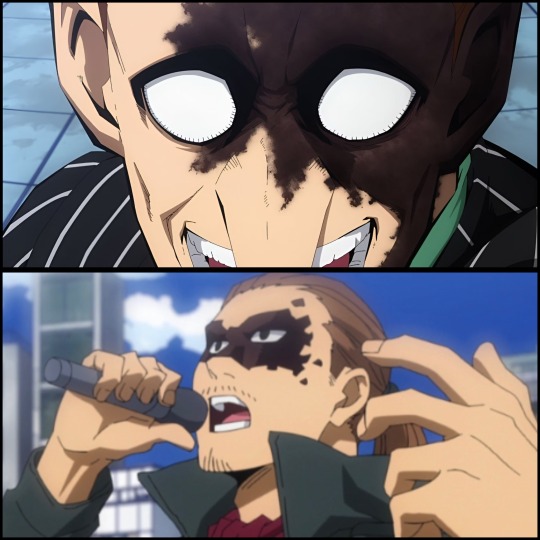
I don’t know what Bones Studio was thinking when they decided to make this choice, But in the anime Re-Destro claimed and was heavily hinted to be Destro’s son, when all actuality and in the manga, Destro is just his ancestor. There is so many reasons wrong with this and why this couldn’t work.
First of all, the time of Destro being alive wouldn’t work with Re-Destro’s because this was a time quirks were starting to appear and this was a time All For One was starting to make his ways in the world of villainy and All For One is confirmed to be over a hundred years old. (If Re-Destro was Destro’s son then he would be so old and wrinkly at this point of time… Or dead because how?)
Second, It’s just incorrect. It’s not true. Destro is just an ancestor to Re-Destro, Not his father. And when you talk about Re-Destro and Destro to fans who only seen the anime, They get confused when told Destro is actually an ancestor to him and not a father. At this point, If Bones Studio is mixing up the characters’s information. We should too, why not make AFO Shigaraki’s Biological father or make All Might related to Mineta. Because it’s fun ig!?! (Obviously people can have their headcanons, I have mine too! But when a whole studio is just getting information wrong, It’s just annoying)
@Stillness-in-green made a very good post talking about this and explains it much better then I could. So definitely check that out!
—————————-
More Minor Mistakes Before We Talk About The Final One:
*More dialogue from citizens/soldiers missing. (I already explained why this annoys me)
*Some dialogue between Trumpet and Spinner was removed. (Especially since it helps with Spinner’s character development and trimming while still works in the anime in terms of understanding and plot is still frustrating to manga readers)
*A scene of Slidin Go blocking a van from entering at the outside of Deika City when suddenly loud booming noises are heard and the hero mistakes it for earthquakes (While not really a big deal or a must have scene. This would have given Slidin Go more on screen moments… Maybe where he wouldn’t be forgotten).
*A scene/panel of a page from a children’s book talking about being kind to those with Mutant based quirks. (While also not a must, It would have been cute animated. Plus it would have been very funny if that plays after Trumpet gets offended to be compared to Spinner).
*Even though I said I wasn’t going to talk about the scenes missing with the league, this one I will. There’s a scene/panel with young Shigaraki looking on at a mysterious man leaving as his mother bows in apology. (If you’re caught up in the manga, You would know why removing that scene was a big mistake. Once again, Bones Studio picking and choosing what they want to add or not. I had to point this out because that’s what they did with this whole arc.)
*They removed Spinner clinging on Trumpet’s political van as Trumpet tries to reach Re-Destro, Basically clinging on to the van as it drives. (Suppose Spinner just ran over there quick in the anime)
*Re-Destro’s Claustro slowly breaks down in the manga. (Not much to complain. It just would have been cooler animated like that)
*And finally the last thing to complain about is the gore… Or less gore in the anime…
————————————
Bones Studio Censoring The Gore Of The Meta Liberation Army Arc:
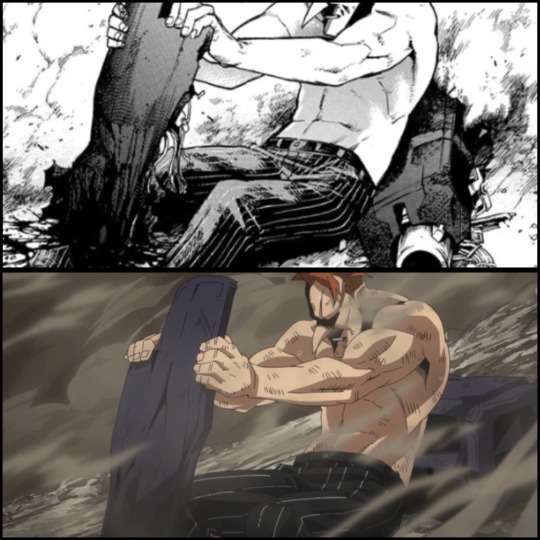
When people complain and talk about the comparison of censorship between the manga and anime of My Hero Academia, it’s this arc that has a lot of examples… A lot. While I’m aware and understand that this is a TV-14 rated show, it’s still in the manga and it should be represented to keep it faithful. The violence was toned more down with Giran’s bruises, to Toga’s bloody face from Curious, Shigaraki getting his fingers snapped off, and finally to the one picture above where Re-Destro’s legs were chopped off to save himself from decaying from Shigaraki’s quirk. The final scene with Re-Destro bowing to Shigaraki as his new leader was so chilling yet so cool in the Manga. It’s cool in the anime, But we could have had much more of it if it wasn’t toned down. It just feel like a cop out and lazy on Bone’s part…
————————————
In Conclusion:

After the scenes I talked about, Everything is almost pretty much the same in the anime as in the manga as well, leaving my talk of the Meta Liberation Army Arc closing.
While I’m thankful for Bones Studio animating the anime I love, I feel frustration with how they handle not only the Meta Liberation Army but characters that are not as popular to fans or the main characters, Villains or not. Bones Studio usually will focus on characters that are more popular and give them as much screen time as they can while depriving others who aren’t as popular with scraps. (If you also notice, Throughout my talk, I had no complains of Geten’s scenes because he was usually seen with Dabi who is considered a popular character. So Geten’s scenes remain in tact because Bones knows Dabi is popular)
What caused them to do what they did to the Meta Liberation Army in the anime adaptation is beyond me? Whether it’s simply not caring about them, putting more focus, time, and money on characters that are more popular, Someone even theorized it was to put the budget of animation on the filler episodes or the movie that was coming up at the time. Whether it was, the fact that the characters I love were discarded and basically fans either don’t know or don’t like/care about the MLA and/or Arc, Hurts because THIS IS MY FAVORITE ARC. And I’ll be damned if I lie and say it isn’t because a lot of people say otherwise.
Whether anime or not, The MLA and the arc will still remain my favorite even if the studio working on doesn’t think so. These are characters I love and value a lot when it comes to My Hero Academia. But with how the Meta Liberation Army was handled and continued to be handled in the anime to this day is just frustrating. In Conclusion, Bones Studio do better…
——————————————-
#bnha#boku no hero academia#mha#my hero academia#analysis#rant#re destro#rikiya yotsubashi#trumpet mha#koku hanabata#skeptic mha#tomoyasu chikazoku#curious mha#chitose kizuki#geten#meta liberation army#mla#I have so much beef with Bones Studio’s executive decisions#mha villains
138 notes
·
View notes